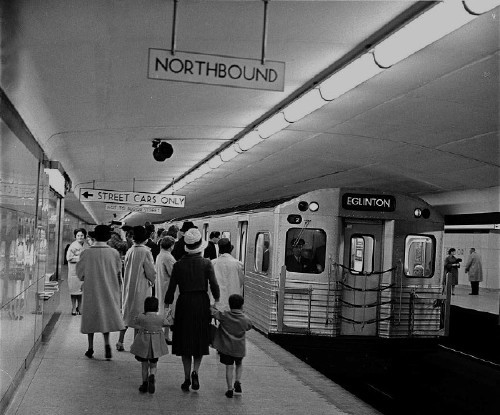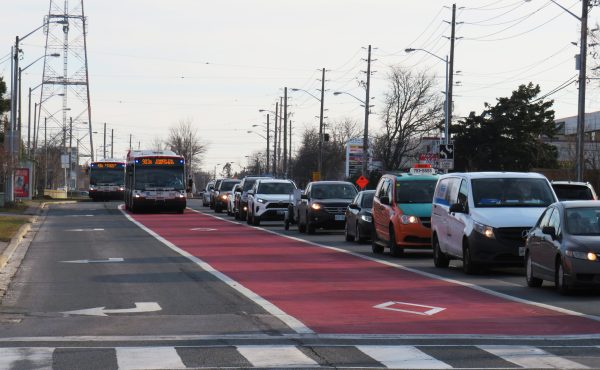
The ever-thorough Joe Clark has two excellent posts that you should definitely know about. The first post involves a lengthy look at the TTC’s subway signage and typography (and delves into the lack of hertiage sign preservation). The post, “Inscribed in the living tile: type in the Toronto subway,” was presented recently at the ATypI 2007 conference, in Brighton, U.K.
The other post is about advertising-domination in a subway station. Some of the interesting findings:
• More people are opposed to station domination. When asked the question “If the TTC were to allow advertising on the floors, ceilings, and pillars of subway stations, would you be†in favour or opposed? 43% were opposed, while only 39% were in favour. 15% didn’t care. 3% would have to see the ads first.
• Unprompted, people gave reasons not to use station-domination advertising: Already enough ads (≈37%), ugly (20%—29%), intrusive (18%—29%), distracting (≈16%), “don’t pay attention to ads†(≈11%).
• When asked the question “Should TTC allow advertising for one company, using all locations you see here, at other subway stations,†about 48% answered no and at most 35% answered yes.
• Up to 13% of respondents stated that station-domination advertising made it harder to find and read signs in the system.
What Clark finds in the reports is the TTC twisting facts to support advertising domination even though the numbers state the public has other wishes. Read the posts for all the details.
photo from Toronto Archives




20 comments
“More people are opposed to station domination. When asked the question “If the TTC were to allow advertising on the floors, ceilings, and pillars of subway stations, would you be†in favour or opposed? 43% were opposed, while only 39% were in favour. 15% didn’t care. 3% would have to see the ads first.”
What I see in that is not much of a spread between the Yes and the No people. And if the Maybe people liked the ads they were presented, there’s only a 1% difference. If anything, I would say “only 43% opposed”, which is more unfortunate.
Of course people don’t want ads for beauty’s sake, otherwise we’d all be picking up Bud Light or Tide wallpaper for the living room. If you phrase the question as “Would you prefer the TTC allow advertising on the floors, ceilings, and pillars of subway stations or raise fares 25 cents?” you might find a different answer, which I imagine is what the TTC is referencing.
I wish people still wore hats and coats like that.
You’re ever so much more gracious to miserable old Joe Clark than he is capable of being to you.
You might find a different answer if the advertising really would have that much of an impact on fares, but the numbers suggest they wouldn’t.
2006 “passenger services” revenue (i.e. fares): $741M
2006 “advertising” revenue: $15M
Suggested additional possible revenue from more aggressive advertising (Star article): $7M
The existing advertising revenue represents a whopping 2% of fare revenue. If we max out advertising, maybe we bring that up to 3% of fare revenue. Or, another way that I believe TPSC has framed it, is that we could remove all advertising on vehicles and in stations and replace the revenue with a nickel hike on tickets, and roughly $2 on a Metropass.
A lot of people seem to think increased advertising could be a panacea that solves the TTC’s budget woes. Even the $7M figure sounds impressive, until it’s shown how little it is compared to fare revenues. I’m not advocating a removal of advertising from the system (I’m sure lots of Spacing readers/writers would disagree), and there is something to be said for the concept of “every little bit helps”. But, like other modest incremental measures (e.g., the oft-touted councillor perks), the revenues/savings would be comparatively low and perhaps largely symbolic.
I wish the TTC was still making signs like that.
I wish the signs, and the coats and hats (indeed, Gloria), in the picture were still made like that.
Yes, the midcentury typeface sure does put the “glint” in Eglinton.
In other news:
Helvetica walks into a bar.
Times says, “Ouch!”
“What’s wrong, Times?”
“You’re standing on my serif!”
I used to feel that way about hats, but if you really think about it, hat nostalgia is just naive and silly. Hats were basically class markers. No one’s stopping you from wearing hats, but I’m glad that we don’t have to worry about wearing the right hat.
SK> What isn’t a class marker then? Everything sort of points to something.
I didn’t mean to put down anyone, I was offering it as a friendly counterpoint to the hat revival people as I have put a little bit of thought in this topic before.
True, everything can be seen as such, but to me that stands out as headgear’s only purpose. It is such an apparent sign of class and that is why I don’t want a revival. I formed this opinion when wondering about what type of hat I would wear in different situations if we lived in a hatted society. Because I am of Indian origin, I would wear traditional hats in some situations, and thinking of hats and what they meant in the context of Indian society in the time when they were very common, I concluded that hats were nothing but signifiers of difference, in terms of class, caste, religion and sect, and were therefore were not a very positive thing.
Just do a thought-experiment and you will see that mass hat-wearing is an institution better left unresuscitated. You would see hat sub-cultures develop in rebellion to the popular culture, which would themselves become part of the popular culture in around 15 years. You would have people moving on up in hat style, and then you would have conservatives who would say that people should know their role and stick with their own hats. They would criticize immigrants for not adapting and continuing on wearing their old hats. You would have hipsters aping the hat style of workers using hat-equality as an excuse and so on and so forth. I think sometime in the 60’s, we as a society signed a contract to eliminate this unnecessary hat-race altogether, and I don’t think we should look back. 🙂
The hat race was replaced by the Moon Race and the Arms Race in the 60s then.
—
I do understand your point, though I think if you were to go a step further, it applies to all clothing. And we see the recent Hoodie thing in some jurisdictions — trying to ban them, etc. The only way to get around it is if we all wore the same thing. Like robes or something.
I’m just nostalgic for the days when people, high and low, were generally a little less slobby, and slightly more formal when out and about. And uh, just the fonts were completely uniform.
I’m sure everyone will be thrilled to know that I still rock a fedora every day.
High-fives, Sean!
True to form, Spacing views its comments section as an open forum for character assassination. Someday an adult will take over the site and actually police its comments.
Hey, Denby, come over to my neighbourhood and say that to my face.
I think the main issue is that with all of the real estate available TTC *only* makes 15m. Is TTC selling its space for peanuts or something?
Also – if I recall correctly the sale of ads from transit shelters benefits the general city coffers, not TTC.
I apologize for not being able to remember which report it is off hand but I’ve read TTC reports that say Toronto gets rates comparable and above other similar cities (Canadian and American) for its advertising space.
Clark’s above comment is one of the richest I’ve ever read from him on this site: he has an freaking entire section of his web site dedicated to assassinating the character of Spacing and its editors (which is packed full of wrong facts I might add), does not allow anyone on his site to make comments, makes a childish comment of his own (“come over to my neighbourhood and say that to my face”) but still has the nerve to say “some day an adult will take over this site.”
Unbelievable. Bravery from behind a keyboard is one of the worst attributes of the 21st century.
39% of participants were in favour of putting advertising on the floors, ceilings, and pillars of subway stations
Wow.
Has anything changed regarding the status of the TTC’s indoor/outdoor ad contract? The Coupler cites a seven year deal (with Viacom — now CBS) being signed in 2005.
And what’s the holdup on installing the OneStop platform monitors? (Is it due to politricks, to use Mr. H. Wilson’s term?)
I’ve actually had to start wearing a wristwatch-thingy because the “Metrons” (and their large time displays) are almost all dead or gone… Poor me.
PS: Kudos to spacing, for drawing attention to Joe’s recent work as well as providing a place to (for better or worse) discuss these issues.